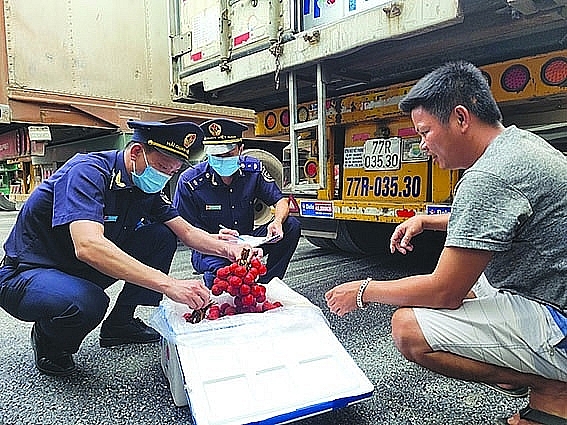Opportunity to accelerate agricultural export to China
For many years, China has been Vietnam's largest trading partner. Trade between Vietnam and China has maintained a stable and sustainable growth momentum.
 |
|
Tan Thanh Customs officers (Lang Son Customs Department) guide enterprises in packaging lychee for export. Photo: H.Nu |
Key export market
In the first 9 months of 2024, the bilateral trade turnover between Vietnam and China reached nearly US$ 148.6 billion. Of which, export to the Chinese market is estimated at US$ 43.56 billion, import from China is estimated at US$ 105 billion, accounting for nearly 38% of the total import turnover of the country.
In particular, for fruits and vegetables, in the first 9 months, China continued to be the largest market with a turnover of US$ 3.79 billion, an increase of 37.82% over the same period last year and accounting for 67.2% of the total export turnover of fruits and vegetables of the country.
Ms. Le Thi My Hanh, General Director of Banana Brothers Farm Joint Stock Company - a company exporting bananas to the Chinese market, said that currently the world market's demand for fruit was very large, in which China was a very potential export market for Vietnamese fruit.
According to Ms. Hanh, with agricultural products and fresh fruits for export, compliance and ensuring product quality was the most important thing. The Chinese market, as well as Japanese, Korean, European, American ones... all have similar general standards on quality and trace amounts of pesticides to ensure the health of consumers.
Banana Brothers Farm representative analysed that if fruit exporting enterprises only focused on European and American markets... and ignored China, it would be a big mistake, because Europe and America were markets with very far geographical distances, and the issue of freight costs and transportation time for fresh fruit was not favourable.
Furthermore, China is known as a billion-people market because its consumption of fresh fruit is very large and has great potential.
“The demand for bananas in this country is particularly high, then exporting bananas in particular and fresh fruit in general to neighbouring countries is no a matter of competition, but rather that whether we have enough capacity to meet the demand”, Ms. Hanh raised the issue and added that the partners being import enterprises in China were very enthusiastic, creating favourable conditions for Vietnam to ensure the fastest and best source of fresh fruit exported to the neighbouring country.
At the same time, the Chinese consumer community also highly appreciates and values fresh fruit products from Vietnam. Therefore, exporting fresh fruit to China is always a potential market.
Sharing the same opinion, Ms. Nguyen Thi Diem Hang, Chairwoman of the Board of Directors of Vietnam Organic Nutrition Food Joint Stock Company, said that with more than 11 years of exporting to China, the company could affirm that China was a very potential market, moreover, consumers in this market also had a lifestyle and shopping style quite similar to Vietnamese people.
Therefore, this is a market that Vietnamese enterprises should continue to invest and exploit because of the advantages of nearby logistics.
According to the Trade Promotion Agency (Ministry of Industry and Trade), China has always been identified as the largest and most important export market for agricultural, forestry and fishery products of Vietnam. In the first 9 months of 2024, the export turnover of agricultural, forestry and fishery products to China reached US$ 9.26 billion.
To date, Vietnam has officially exported 14 agricultural products to the Chinese market, including durian, bird's nest, sweet potato, dragon fruit, longan, rambutan, mango, jackfruit, watermelon, banana, black jelly, mangosteen, lychee and passion fruit.
Vietnamese durian, dragon fruit... are very popular with Chinese consumers. Import of these products from Vietnam account for about 1/5 of the total agricultural products imported from ASEAN.
Also according to the Trade Promotion Department, recently, the Ministry of Industry and Trade has closely coordinated with the Ministry of Agriculture and Rural Development in negotiating with China to open more export markets for other Vietnamese fruit and vegetable products such as green-skin grapefruit, fresh coconut, avocado, pineapple, star apple, lemon, melon...
Proposing to improve efficiency and regulate the speed of customs clearance of import and export goods at border gates between Vietnam and China, especially for seasonal agricultural and aquatic products; quickly and strongly shifting to official export.
With the above efforts, during the visit of General Secretary and President To Lam to China in August 2024, the Ministry of Agriculture and Rural Development of Vietnam and the General Administration of Customs of China signed three protocols, paving the way for the export of fresh coconuts, frozen durians and crocodiles to this market.
The signing of Protocols allowing the official export of agricultural products has created momentum for many types of Vietnamese agricultural products in this market. Durian is an example.
After the Protocol on the official export of durian to China, the export value of durian from Vietnam to this market in the past 2 years has been much larger than the previous years combined.
In 2022, durian export will reach US$ 420 million, reached US$ 2.3 billion in 2023, 5 times higher than in 2022 and 10 times higher than in 2021, of which over 90% was exported to China.
Exploiting the advantage
The Trade Promotion Department also assessed that the results achieved in the past had not been commensurate with the potential, needs and strengths of each side. Currently, in addition to 14 types of agricultural products exporting by official channels, most of the remaining items were exported through border trade channels (informal trade), while the demand for fruit consumption in the Chinese market was very large and the ability to supply high-quality, specialty fruits of Vietnam was very abundant; the advantages of bilateral and multilateral trade agreements of two countries are available.
In particular, Vietnam is also a country with more than 1,450 km of border (waterway, road) with China, so logistics costs are lower and more competitive than other countries. Therefore, there is still a lot of room for fruit enterprises of the two countries to exploit and develop.
At the 13th meeting of the Vietnam - China Economic and Trade Cooperation Committee, held on September 29, 2024, in China, Chinese Minister of Commerce Wang Wentao proposed that Vietnam should strengthen investment and supply chain cooperation; focusing on implementing investment cooperation documents and digital economy - green development initiatives agreed upon by both sides; requested that Vietnam should have policies to support and encourage the development of power projects; industrial park cooperation; continue to negotiate and sign a memorandum of understanding (MOU) on strengthening economic cooperation in the production and supply chain...
At the same time, Minister of Trade Vuong Van Dao also proposed solutions to promote trade cooperation, including negotiating and signing documents on agricultural trade cooperation; strengthening e-commerce cooperation; enhancing exchanges on standards and conformity assessment of import and export products; satisfactorily resolving anti-dumping investigations... On the other hand, the two sides discussed and completed the process of joining free trade agreements of new members.
For offering new solutions to promote and further strengthen bilateral economic and trade relations between Vietnam and China, Minister of Industry and Trade Nguyen Hong Dien proposed that the two sides should strengthen cooperation, ensure smooth customs clearance at border gates; coordinate in sorting goods for customs clearance, notify each other in advance of customs clearance information for electromechanical products, agricultural and aquatic products, fruits and other goods…
At the same time, coordinate the flow of goods in a balanced and effective manner among land border gates. Currently, the volume of import and export goods is still concentrated a lot in Lang Son province, while other border gates in Quang Ninh, Cao Bang, and Lao Cai have also invested in very good transport infrastructure and wharfs, but have not been fully exploited.
In addition, the two sides need to continuously upgrade and improve border gate infrastructure, because currently, the flow of people, vehicles, and goods through border gates of the two countries as well as bilateral trade is growing very strongly...
|
During the official visit to Vietnam (from October 12-14, 2024) of the Premier of the State Council of China, Minister of Industry and Trade Nguyen Hong Dien presented two cooperation documents to the Minister of Commerce of China Wang Wentao in the presence of Prime Minister Pham Minh Chinh and Premier of the State Council of China Li Qiang. Cooperation documents include the Memorandum of Understanding on enhancing cooperation in building a sustainable agricultural supply chain between the Ministry of Industry and Trade and the Ministry of Commerce of China; the Memorandum of Understanding on establishing a Working Group to study models for building a Vietnam-China cross-border economic cooperation zone between the Ministry of Industry and Trade and the Ministry of Commerce of China. The signing of the above two cooperation documents with the Chinese Ministry of Commerce is also the basis for the Ministry of Industry and Trade to continue to maintain and promote economic and trade cooperation, especially the export of Vietnamese agricultural products and food to the Chinese market. At the same time, it will accelerate the process of researching and selecting a suitable cooperation model to build a Vietnam-China cross-border economic cooperation zone. |








